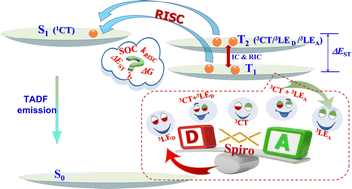Importance of spin-triplet excited-state character in the reverse intersystem crossing process of spiro-based TADF emitters†
Abstract
The reverse intersystem crossing (RISC) process is vital to improving exciton utilization and suppressing efficiency roll-off in thermally activated delayed fluorescence (TADF) materials. However, direct exciton transfer from the lowest triplet state (T1) to the lowest excited singlet state (S1) is not highly efficient when both states have the same charge transfer (CT) nature. Intervention of the local excitation character in T1 states (3LE) might be expected to enhance spin-flipping. In this work, the importance of the excited-state character of T1 in the RISC process is demonstrated on the basis of the theoretical analysis of a series of donor–acceptor (D–A) type spiro-based TADF molecules. Five types of spin-triplet states featuring LEA, CT + LEA, CT, CT + LED, and LED are achieved through fine tuning the D–A interactions. The calculated results indicate that the triplet excited state features have significant effects on the spin–orbit coupling (SOC) constant and reorganization energy of the RISC process (λ), thus determining the RISC rate (kRISC). In particular, λ involved in the RISC is also important for kRISC, which is usually undervalued and not paid enough attention as the singlet–triplet energy gap. This work provides an in-depth understanding of the effect of the triplet excited-state character on the RISC process and establishes the structure–property relationship of spiro-based TADF molecules.



 Please wait while we load your content...
Please wait while we load your content...